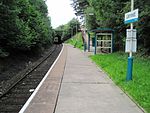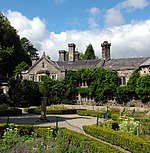Melin-y-Coed
Villages in Conwy County BoroughWales geography stubs

Melin-y-Coed is a small rural village in the county of Conwy, Wales. (Translated as Mill in the Woods into English). The earliest surviving building in the village is Cyffdy Hall, built in 1596.The village lies about a mile and a half southeast of the town of Llanrwst. Behind the village to the east the hills rise to Moel Seisiog (467m). The B5427 links Melin-y-Coed to Llanrwst.
Excerpt from the Wikipedia article Melin-y-Coed (License: CC BY-SA 3.0, Authors, Images).Melin-y-Coed
Geographical coordinates (GPS) Address Nearby Places Show on map
Geographical coordinates (GPS)
| Latitude | Longitude |
|---|---|
| N 53.127 ° | E -3.77 ° |
Address
LL26 0SW , Bro Garmon
Wales, United Kingdom
Open on Google Maps







